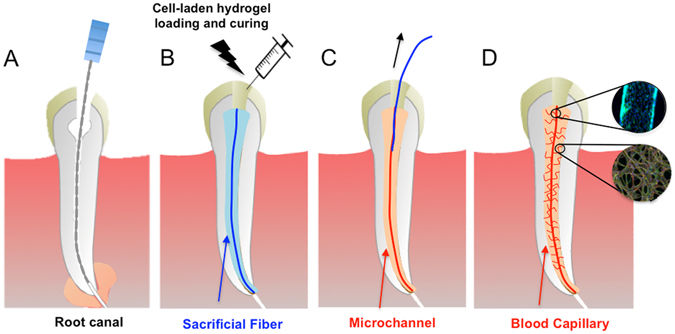Researchers from Oregon Health & Science University (OHSU) have developed a process involving a bioprinter that can engineer blood vessels in extracted teeth.
The findings are expected to have impact on root canal treatments which currently involves removing the tooth’s infected pulp and replacing it with a substance known as gutta-percha. This thermoplastic material is similar to rubber and is used to fill the inside of the tooth but cannot restore function since it removes the blood vessels.

Restoring function
This new research from Oregon hopes to alleviate this problem and restore function to patients’ teeth. Leading the research Luiz Bertassoni, assistant professor of restorative dentistry in the OHSU School of Dentistry, explains that for this reason current techniques are not sufficient. As he says,
This process eliminates the tooth’s blood and nerve supply, rendering it lifeless and void of any biological response or defense mechanism. Without this functionality, adult teeth may be lost much sooner, which can result in much greater concerns, such as the need for dentures or dental implants,
The new approach uses pre-vascularized pulp-like tissue to promote dental pulp regeneration and allow for a better long-term treatment. According to Bertassoni, the research built upon a prior study into the bioprinting of blood vessels. Bioprinting shows much promise in this regard and Californian scientists recently presented their successful research into bioprinted functioning blood vessels. The team were able to showcase their bioprinted vessels could form into an existing framework when implanted into mice and even began circulating blood.

Research process
To provide a proof-of-principle, the researchers worked on an extracted human tooth and implanted a substance consisting of hydrogel, dental pulp cells and endothelial cells. Endothelial cells are those that form the inside of blood vessels.
Once removing the dental pulp from the extracted tooth, the team injected the hydrogel substance complete with dental pulp cells around a fiber mold for the microchannel blood vessel. Building on the prior research, Bertassoni’s team used a bioprinter to create an agarose fiber mold.
Following this, the researchers removed the fiber and replaced it with injected endothelial cells. After seven days, the team found blood vessels began to form as well as dentin producing cells. Dentin is the material which forms the inner layer between dental pulp and the enamel.

Changing the future of root canal treatment
The paper explains that following these successful results, the lab hopes to begin in-vivo trials to determine whether the proposed method could succeed when applied directly. Luiz Bertassoni, who is also assistant professor of biomedical engineering at the OHSU School of Medicine, believes “this finding may change the way that root canal treatments are done in the future.” Bertassoni also states,
This result proves that fabrication of artificial blood vessels can be a highly effective strategy for fully regenerating the function of teeth,
Elsewhere in the world of dental pulp research, Chinese researchers similarly explored the process of growing dental pulp using bioprinting and hydrogel scaffolds in a paper published recently.
The dental industry holds much promise for 3D printing, although not typically on a biomedical sphere, as some see the technology as the future of crown production. The Dubai Dental Authority recently revealed plans to begin 3D printing teeth by the end of 2017.
This paper, titled ‘A Novel Strategy to Engineer Pre-Vascularized Full-Length Dental Pulp-like Tissue Constructs’ has been published in Scientific Reports.
For the latest bioprinting news, subscribe to the most widely read newsletter in the 3D printing industry, follow us on twitter and like us on Facebook.
Featured image shows the artificial blood vessels contained in a hydrogel scaffold. Image via OHSU/Kristyna Wentz-Graff.



